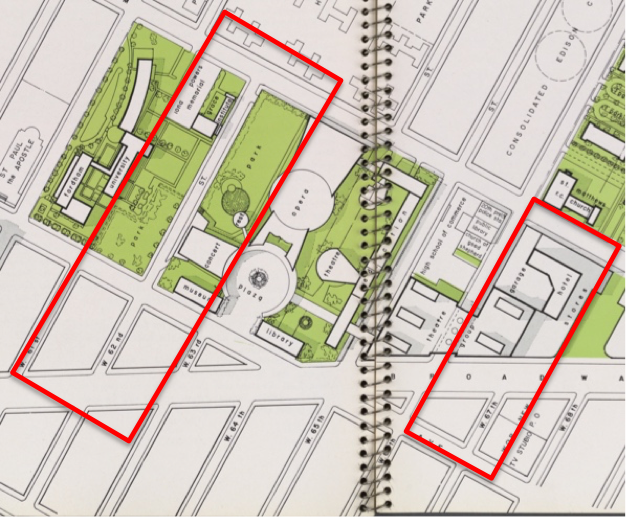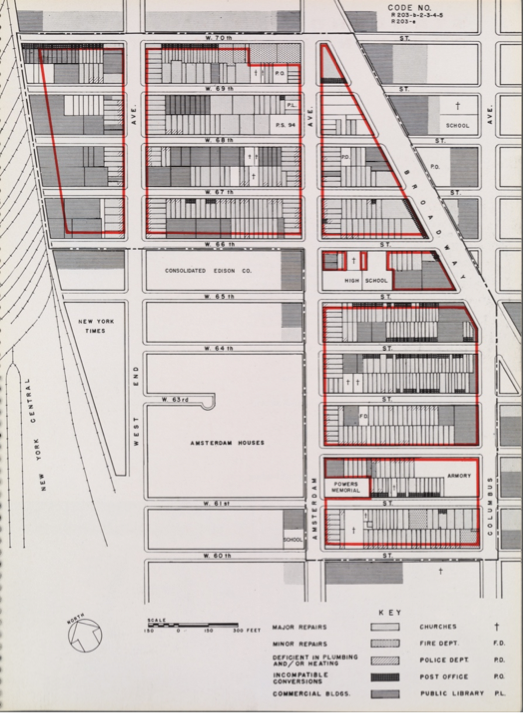In the 1950s, Robert Moses – immortalized as the notorious “master builder” of New York City in Robert Caro’s groundbreaking biography The Power Broker– was involved in multiple urban renewal schemes throughout Manhattan. One of his biggest projects entailed tearing down a neighborhood near Lincoln Square – affectionately called San Juan Hill by its residents – to build the Lincoln Center for the Performing Arts. At least 7,000 families were pushed out of their homes.
The political atmosphere that made such a project possible, and Moses’ own approach to city-building are revealed in the archives of his personal papers in the New York Public Library. As Moses began work on the Lincoln Square Slum Clearance project, San Juan Hill was memorialized as the setting of the 1957 musical West Side Story – currently being revived on Broadway – just as the actual neighbourhood was slated for destruction to make room for a showcase for music and theatre. In the summer of 1968, Lincoln Centre would open curtains on a production of West Side Story, ironically staging the fictional conflict of the Jets and the Sharks on the very blocks cleared for ‘progress’ less than a decade ago.
Robert Moses’ plans would have been impossible without wide support. Despite substantial resistance from the “Save Our Homes” campaign and various tenant activists, his net of allies, stretching from residents to officials in both the City Council and State Legislature afforded Moses, as city planning commissioner, the freedom to “renew” Lincoln Square as he wished. A letter from a local landlord reveals how some allies viewed the sacrifices necessary for “development.”
On September 12th1956, Henry Weil, the owner of multiple residential properties in San Juan Hill, wrote Robert Moses a letter voicing his approval of the Lincoln Square Slum Clearance Plan. After listing the two properties apartment buildings on 62nd and 67th Street, he moves to describing his tenants. The thorough account of their wages and details such as, “about 20% have their own business” display the information Henry Weil considered most relevant to the conversation with Robert Moses. The information implies that the residents were a mix of working class and middle class. Beyond their financial profiles, we do not learn much about the tenants.
Henry Weil goes on to conclude that out of all his tenants, only nine would have to be relocated from the neighborhood. It is appears that Weil thought the rest would be able to afford to continue living in the area – possibly in new housing that was to be built. This is almost certainly a gross underestimate of how many would have to move out of the neighborhood.

According to the site plan from May 1956, 62nd and 67th streets between Broadway and Amsterdam – the locations of Henry Weil’s buildings – were to be absorbed into Lincoln Centre. These residential areas would be turned to storage and green space for the Lincoln Centre of Performing Arts. The shift in the purpose of these streets reflects the overall effect of Robert Moses’ redevelopment of San Juan Hill. The site plan asserts, “The area is predominantly residential in character” before detailing the many changes to be made to the neighbourhood.

Moses’s plan did include building 4,400 units of housing. However, 4,000 of these were advertised as “luxury apartments” and the new buildings hardly made up for the 7000 low-income apartments that were destroyed for the sake of the redevelopment.
Despite its consequences for the residents of San Juan Hill, the prevailing narrative in the media around the Lincoln Square Slum Clearance Plan was celebratory, framing displacement as a necessary step to correcting the “blight” of the neighbourhood. In response to concerns from the Manhattan Council for Social Planning about housing issues caused by his redevelopment, Robert Moses responded in March 1956, “this central part of the City is a desirable and developing area… I believe, viewing the whole picture, that we are doing the most useful thing that we can in the area.” For Moses, the appeal of San Juan Hill evidently lay in its “desirable” location rather than the character of its residents.
Mainstream media hardly acknowledged the plight of San Juan Hill’s residents. On the rare occasion when they were mentioned in coverage of the destruction of their neighborhood, the portrayal was close to caricature. In October 1956, columnist George E. Sokolsky wrote a paragraph on the Lincoln Square development for the New YorkJournal American, one of the city’s major dailies, noting that “many of the inhabitants of this blighted area object to the improvement and beautification of their city,” He likens them to an asthmatic taxi driver who insisted, “This is where I live!” when asked why he did not move to the desert The driver, Sokolsky wrote, “did not suffer social misery; he enjoyed it.” Apparently the idea of financial necessity or emotional connection never occurred to Sokolsky; he reduces the residents’ complaints to mere stubbornness.
Afterward the columnist received a note in the mail. “Dear George, thanks for the paragraph on Lincoln Square. Best, Robert Moses,” it said.
However, no one understood the supposed necessity of displacement better than Henry Weil. He conceded that moving is irksome. “Of course they don’t want to be disturbed. From their view point, it is perfectly understandable,” he wrote, but then concluded,
“Going back to the early period of our city, we can well understand that the Indians also did not want to be displaced by the settlers. The farmers also did not want to see their farms cut up into roads and streets, but intelligent people know that with the passing of time, changes do take place.”
On September 17, 1956, Robert Moses replied, thanking Henry Weil for his part in advancing “the best interests of the entire city”.
Sources:
Archives:
“Robert Moses Papers”, New York Public Library Archives & Manuscripts
Box 116, Committee on Slum Clearance Housing Files 1-3 – 1955-1957:
File 1: Letters between Robert Moses and Henry Weil, 12 and 17 September 1956
Letters between Herbert Sternau of the Park Neighbourhood Association and Robert Moses, 23 February 1956 and 7 March 1956
File 2: “Lincoln Square: Slum Clearance Plan under Title 1 of the Housing Act of 1949 as amended” – Brochure, pages pictured in public domain.
Letters between Joseph Gelberg and Robert Moses, 19 July1956
File 3 of 3: Sokolsky, George E., “Lincoln Square”, Journal American, 24 October 1956
Secondary material:
Caro, Robert A. The Powerbroker: Robert Moses and the Fall of New York(New York: Vintage Books, 1975)